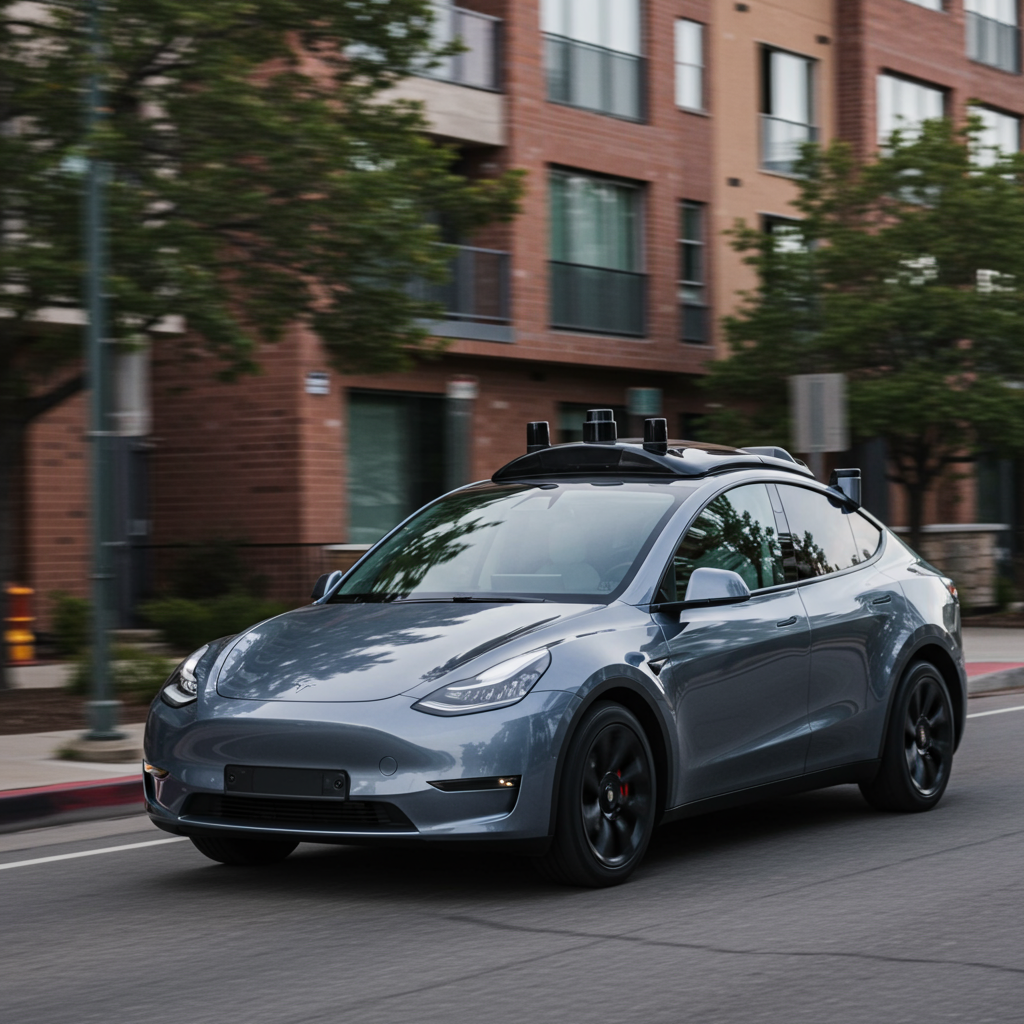tesla CEO Elon Musk recently ignited excitement by announcing what the automaker claims is its first completed driverless delivery of a new vehicle to a customer. This significant event, which reportedly took place on June 27th, involved a Tesla Model Y SUV navigating public roads autonomously from the company’s Gigafactory in Austin, Texas, to a customer’s apartment building in the city.
The official Tesla account on the social platform X, also owned by Musk, shared a video showcasing the Model Y undertaking this journey without any human present in either the driver’s or front passenger seat. This demonstration was presented as a major step forward for tesla’s autonomous driving ambitions, suggesting progress towards achieving true unsupervised capabilities.
The Claim: An Unsupervised Journey from Factory to Customer
According to Elon Musk’s posts on X on June 28th, the first “fully autonomous delivery” of a Tesla Model Y from the factory end-of-line to a customer’s home “across town,” including highway segments, was completed “a day ahead of schedule.” Musk explicitly stated there were “no people in the car at all and no remote operators in control at any point,” emphasizing the “FULLY autonomous” nature of the drive.
The video shared by Tesla depicts the Model Y successfully traversing various environments. This included navigating public highways, driving through residential streets, maneuvering around parking lots, and finally arriving at the curb of an apartment building for the handoff to the waiting customer and Tesla employees. Tesla’s AI director, Ashok Elluswamy, also posted on X, asserting that the customer was “literally chosen a random customer who ordered a Model Y in the Austin area” and that the vehicle delivered was “exactly the same as every Model Y produced in the Tesla factory,” aiming to dispel notions of a specially prepared test. Elluswamy also noted the vehicle reached a maximum speed of 72 mph during the drive.
Was Tesla Truly the First Fully Autonomous Public Highway Drive?
While Tesla and Musk celebrated this as a potential “World’s first autonomous delivery of a car,” Musk’s accompanying claim about it being the “first fully autonomous drive with no people in the car or remotely operating the car on a public highway” warrants closer examination. External reports quickly noted that other companies in the autonomous vehicle space have already achieved similar feats, particularly concerning highway driving without human occupants.
Alphabet-owned Waymo, a key competitor, has been operating commercial robotaxi services carrying passengers in multiple U.S. cities for some time. Crucially, Waymo has already been offering fully autonomous rides to employees on freeways in Phoenix since 2024 and has since expanded these unsupervised highway operations to public passenger services in San Francisco and Los Angeles. This history suggests that while Tesla’s achievement marks a significant step for their technology and potentially a novel use case (factory-to-customer delivery), it does not represent the absolute first instance of a vehicle operating fully driverless on a public highway without human intervention.
The Robotaxi Paradox: Contrasting Confidence Levels
One of the most peculiar aspects highlighted by observers is the stark contrast between this claimed unsupervised delivery and the status of Tesla’s recently launched robotaxi pilot program in Austin. Tesla began this pilot shortly before the driverless delivery announcement, deploying 10 to 20 Model Y SUVs for selected, invited riders, often influencers and analysts.
However, unlike the seemingly unsupervised delivery vehicle, the Tesla robotaxis operating in the pilot program still require a human safety supervisor present in the front passenger seat, in addition to being remotely supervised by employees in an operations center. This situation presents an apparent paradox: Tesla seems confident enough in its system to send an empty car unsupervised on a highway and through city streets for a delivery, yet deems the same technology unreliable enough to require multiple layers of supervision when a human passenger is inside.
Recent reports and videos shared online have documented instances of the Austin robotaxis exhibiting glitches during operations. These include vehicles struggling with maneuvers like left turns, briefly entering opposing lanes, and performing sudden hard braking events. These “hiccups” have drawn the attention of regulatory bodies, with the National Highway Traffic Safety Administration (NHTSA) reportedly reaching out to Tesla for more information regarding specific occurrences within the robotaxi program. NHTSA is already conducting broader investigations into Tesla’s FSD systems over potential safety defects.
A Pattern of Lofty Promises and Lingering Skepticism
Skepticism surrounding Tesla’s autonomous driving milestones is not new and stems from the company’s history of ambitious timelines and public demonstrations that have faced later scrutiny. Since 2016, Elon Musk has consistently promised that Tesla vehicles would soon be capable of full self-driving with simple software updates, even outlining a vision where owners could add their cars to a shared “robotaxi” fleet for income generation.
In 2019, Musk famously predicted Tesla would have 1 million robotaxis on the road by 2020, a claim that helped secure significant investment at the time but has not materialized. Furthermore, past demonstrations have been controversial. The company’s 2016 “Paint It Black” Autopilot video, which depicted a vehicle driving itself with a human present only “for legal reasons,” was later revealed in deposition testimony to have been staged and not fully representative of the technology’s capabilities at the time. Both the video and related blog post have since been removed from Tesla’s site. More recently, a 2024 demonstration of prototype robots was later reported to have involved remote tele-operation.
A central reason skepticism persists is Tesla’s persistent failure to release comprehensive public data regarding the safety and performance metrics of its Full Self-Driving technology compared to human-driven vehicles. Unlike some competitors, Tesla has historically relied on demonstrations and claims rather than publishing detailed safety statistics over millions of miles driven autonomously.
Beyond the Demo: Implications and Broader Context
While the recent driverless delivery demonstration was a technical feat, its long-term implications and scalability remain subjects of debate. As a potential method for new car distribution, autonomous delivery could theoretically save costs on destination fees and logistical complexities. However, it also introduces new risks, such as potential vehicle damage during transit, accumulation of dirt, and limitations imposed by range. The legality of unsupervised autonomous operations also varies significantly by state, posing a regulatory hurdle for widespread adoption as a delivery method.
The timing of this highly publicized autonomous delivery announcement is also notable. It occurred just ahead of Tesla’s expected disclosure of its second-quarter vehicle production and delivery numbers on July 2nd. Analysts polled by Tesla’s investor relations team reportedly anticipate a significant year-over-year decline in Q2 deliveries. The focus on advancing autonomous driving technology may serve to divert attention from challenges in Tesla’s core electric vehicle sales business, which is also facing increased competition, particularly from more affordable models offered by Chinese manufacturers like BYD, Nio, and Xiaomi.
Furthermore, Tesla is navigating brand perception challenges, partly linked to controversial statements made by its CEO. These factors collectively add layers of complexity to evaluating the true significance and future impact of this claimed first driverless delivery.
Frequently Asked Questions
What did Tesla announce regarding its first driverless delivery?
Tesla CEO Elon Musk announced on June 28th that the company completed its first “fully autonomous delivery” of a new Model Y from its Austin, Texas, Gigafactory to a customer’s home on June 27th. According to Musk and Tesla, the vehicle completed the journey, including highway driving, without any human present inside or operating it remotely.
Where did Tesla’s claimed first fully driverless delivery occur?
The reported first fully driverless delivery took place in Austin, Texas. A Tesla Model Y SUV drove autonomously from the Tesla Gigafactory located outside the city to a customer’s apartment building address within Austin. This journey included navigating various public roads and environments in the Austin area.
Does this driverless delivery mean Tesla’s FSD is now fully unsupervised?
While Tesla claimed this specific factory-to-customer delivery was completed without human supervision, it does not necessarily mean Tesla’s Full Self-Driving (FSD) technology is generally operating unsupervised. Notably, Tesla’s recently launched Austin robotaxi pilot program currently requires a human safety supervisor in the passenger seat, along with remote supervision. This single successful unsupervised delivery contrasts with the supervised nature of their active commercial service, raising questions about the system’s overall readiness for unsupervised deployment.
Conclusion
Tesla’s claimed first fully driverless delivery of a Model Y from its factory to a customer in Austin is undoubtedly a technical demonstration of its autonomous driving capabilities operating without human intervention. However, the significance of this event is nuanced. While potentially a step towards new delivery methods, the claim of being the “first” fully autonomous vehicle on a public highway without occupants is challenged by the existing operations of competitors like Waymo. Furthermore, the timing and context surrounding recent documented issues in Tesla’s supervised robotaxi pilot program, ongoing NHTSA scrutiny, and a history of ambitious, sometimes unfulfilled, promises mean this milestone is viewed with a degree of skepticism. Moving forward, the industry and regulators will be watching closely for more widespread, consistently reliable autonomous operations and crucially, the release of verifiable safety data to support Tesla’s claims.



